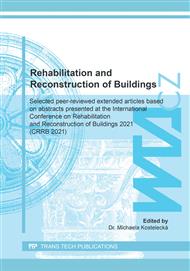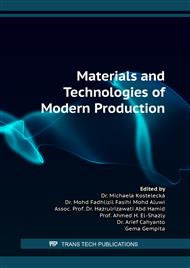[1]
M. Utesena, R. Pernicova: Increasing durability of surface layers of architectural concrete structures with regard to environmental sustainability, International Multidisciplinary Scientific GeoConference Surveying Geology and Mining Ecology Management, Vol 18(5.2), pp.537-544, (2018).
DOI: 10.5593/sgem2018/5.2/s20.070
Google Scholar
[2]
A. Lopéz, G.A. Guzmán, A.R. Di Sarli: Color stability in mortars and concretes. Part 2: Study on architectural concretes, Construction and Building Materials 123, pp.248-253, (2016).
DOI: 10.1016/j.conbuildmat.2016.06.147
Google Scholar
[3]
V. Penttala: From freezing and thawing pore water pressure to concrete stresses, Rilem, p.147–160, (2002).
Google Scholar
[4]
J. Kruschwitz, J. Bluhm: Modeling of ice formation in porous solids with regard to the description of frost dam-age. Computational Materials Science 32, 2005, p.407–417.
DOI: 10.1016/j.commatsci.2004.09.025
Google Scholar
[5]
G. Fagerlund: Mechanical damage and fatigue effects associated with freeze-thaw of materials. In: Frost resistance of concrete from nano-structure and pore solution to macroscopic behaviour and testing, Essen, Germany, p.117–132, (2002).
Google Scholar
[6]
G. Fagerlund :A service life model for internal frost damage in concrete, reportTVBM-3119, Div of BM, Lund IT, Sweden, (2004).
Google Scholar
[7]
R. Pernicova: The susceptibility of forming efflorescence on concrete depending on the mould-releasing agent, Advanced materials, mechanical and structural engineering, pp.151-154, (2016).
DOI: 10.1201/b19934-34
Google Scholar
[8]
V. Hospodarova, J. Junak, N. Stevulova: Color pigments in concrete and their properties, in International Journal for Engineering and Information Sciences, Vol. 10, No. 3, p.143–151 (2015).
DOI: 10.1556/606.2015.10.3.15
Google Scholar
[9]
N.A Baykan, N. Yilmaz, G. Kansun: Case study in effects of color spaces for mineral identification, Scientific Research and Essays, vol. 5 (11), pp.1243-1253, (2010).
Google Scholar
[10]
M. Utesena, R. Pernicova: Color intensity of architectural concrete depending on the type of cement, Materials Science Forum, vol. 986, pp.50-54, (2020).
DOI: 10.4028/www.scientific.net/msf.986.50
Google Scholar



